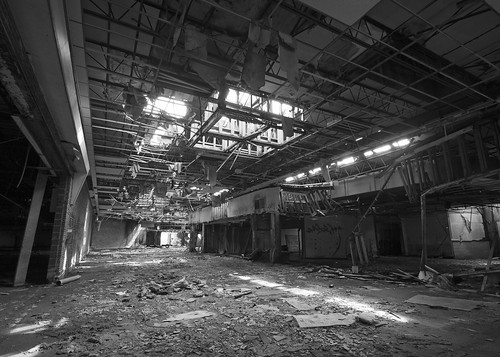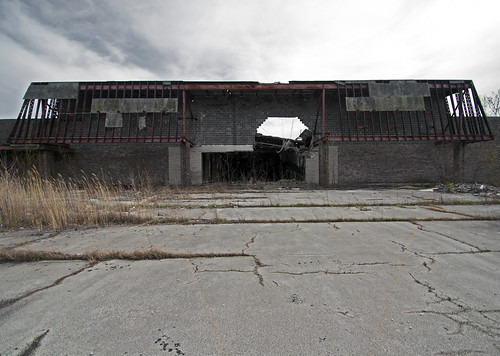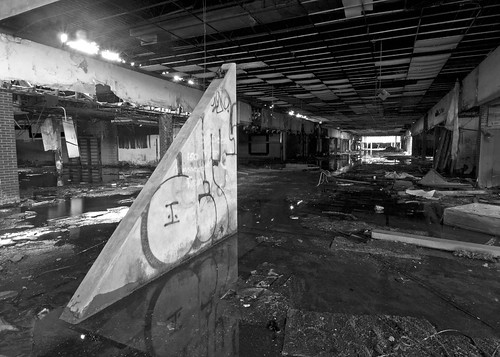Photo: One of the entrances to the famous Dixie Square Mall.
After World War II the newly minted American middle class became emboldened by prosperity and moved further away from city centers into suburbs. Larger homes, new automobiles, televisions and all sorts of consumer goods all became part of the conspicuous consumption norm to demonstrate affluence. There is perhaps no greater symbol that expresses American style consumer culture in the suburbs than the shopping mall.

Photo: Main thoroughfare in the Dixie Square Mall.
In 1966 the still under construction Dixie Square Shopping Center in the southern Chicago suburb of Harvey, Illinois opens its doors to those living the American Dream. The $25 million complex opens strong with 50 stores that included Walgreen’s and Jewel. Big name retailers such as JC Penney, Montgomery Ward’s, and Woolworth’s occupy the anchor locations. Dixie Square is quite successful until about 1970 when rapidly changing demographics, a declining tax-revenue base, and plummeting property values in Harvey began put economic pressure on businesses. Throughout the 1970’s the future of Dixie Square is in turmoil despite several renovation attempts to attract new customers. The store population gradually decreases to the point where the big name anchor stores finally move to other locations.
Video: Clip from the making of The Blues Brothers.
The mall closing in November, 1978 proves to be a windfall for producers of “The Blues Brothers.” There is an iconic car chase scene in the film where the main characters played by Jim Belushi and Dan Akroyd attempt to escape the police by driving right through the mall. Once filming wraps up the mall returns to its dormant state.
Frequent break-ins to the shuttered mall lead to vandalism, arson, and theft of anything of value. In 1985 some the structural adornments are removed and expose the interior to the elements. This hastens the spread of water, mold, and structural decay throughout the mall. As the building deteriorates it attracts more criminal gang and drug activity throughout the 1990’s. In 1993 Raymond Eaves lures Denise Shelby into the old JC Penney store before raping and strangling her to death. The courts sentence Eaves to life in prison in October, 1997 for his brutal crimes.
Dixie Square inadvertently attracts a new clientele in the 2000’s when the site is detailed on the internet. Digital cameras make it easier to share photos of the mall on websites dedicated to the exploration of abandoned buildings. Perhaps aided by its movie history the mall became a magnet within urban exploration circles.
Photo: The second floor of JC Penney lies on the first.
The newfound activity may have sparked redevelopment interest in the location, but the faint glimmers of hope are quickly snuffed out. In 2005 the old Montgomery Ward’s building is purchased by American Kitchen Delights. Rather than dispose of the debris properly, the contractors push it out of the building entrances and into the mall. It is then discovered that the debris contained asbestos and all renovation efforts cease. In 2006 the property is sold to developer John Deenen of the Emerald Property Group and security measures are erected. The first buildings to go are the Montgomery Ward’s building and energy facility, but understandably disgruntled United Demolition workers leave the site after not being paid by Deenen. Rather than settle things in the courts Deenen threatens one of the contractors with brass knuckles, a sawed-off shotgun, and pistol. Deenen is quickly arrested for his aggressive confrontation style.
In September, 2010 Illinois Governor Pat Quinn announces that he plans to allocate $4 million dollars in federal funds to the demolition of the Dixie Square Mall. As of April, 2011 there have been no visible signs of demolition other than the unrelenting efforts of time and nature. There is still hope in the Harvey community that something will come of the massive eyesore though. Future plans for the site include… a shopping center.
Photo (ifmuth): The courtyard in front of the JC Penney store.
The urban explorer responsible for writing the Dead Malls article on Dixie Square Mall which became a resource for many urban explorers revisited his thoughts on the subject years later. His observations on the decay of the mall in the broader context of suburb development is stunningly accurate as it is succinct. In a relatively short amount of time suburbs like Harvey spring up around urban centers and have in influx in population growth. The population of a suburb traditionally commutes to work centers located elsewhere. Without a core work center suburbs are generally homogenous and have nothing to distinguish them from the next suburb. As the population grows the suburbs will continue to spring up in other areas. Consumers are typically attracted to new development. In the 1950’s and 60’s Harvey was on the cusp of growth outside of Chicago, but by the 70’s the wave of middle to upper class residents were moving on. Poor urban planning did not give Harvey anything to stand out among the rest of the suburbs and affluent residents had little reason to stay.
Photo: The building seemingly swells to life after a morning shower.
Dixie Square Mall is a fascinating specimen among urbex locations. For over thirty years the building has been exposed to the caustic effects of neglect. In the past decade urban explorers have documented the decline in great detail. Due to the mall’s online presence I had known about Dixie Square Mall for years, but never got around to devoting the time to visit it. This location taught me to capitalize on photographing an urbex location as soon as possible. So much of the flair that I had seen in online galleries is now missing entirely. Despite the advanced decay, I still managed to have a phenomenal exploration. A morning shower seemed to give the massive structure a breath of life. The steel girders moaned with the wind in every store. The broken concrete channelled the water to areas where different types of flora took root. In one area I was startled by two adult Canadian geese and six yellow gosslings.
The vast open retail spaces reminded me of Port Plaza Mall in downtown Green Bay. As a teenager I spent a lot of my youth killing time with friends in the arcade, videogame store, and media stores. Things began to turn in the mid-90’s and the number of stores began to dwindle. What was once a beautiful shopping center began to become an eyesore. Development in the Green Bay suburb of Ashwaubenon exploded and drove business to the expanding Bay Park Square Mall. The Ashwaubenon location of Lambeau Field may have also contributed to Green Bay’s downtown decline as the Packers climbed their way to a Super Bowl victory at the same time. Just like Dixie Square Mall the owners renovated and rebranded Port Plaza Mall to Washington Commons. The effort did not have the intended effect and the mall floundered until closing in 2006.
When I sat down to do this writeup I thought that there would be little for me to say. The Dixie Square Mall has been covered extensively before and I wondered if just posting a few photos and links would be enough to say I checked this one off my list. It is a fine urbex location despite the extensive damage and seemingly void corridors paying homage to the wonders of consumerism.
Resources:
Atlas Obscura – Short article summarizing the history of the mall.
BookRags – Has a chronological history with dates of significant events at the mall.
Chicago Breaking News – Announcement of demolition from 2010.
Chicago Tribune – 2010 Article where Gov. Quinn announces plan to raze Dixie Square with $4 million of federal funds.
CLUI – Small photo gallery of the mall.
Columbia Chronicle – Article talks about Brett Tracy’s efforts.
Dead Malls – First detailed the mall in 2001.
Facebook – Group for Dixie Square Mall.
Flickr – Mike Brown’s excellent Dixie Square Mall set. Includes great photos from the 1960’s.
Flickr – My own Dixie Square Mall set.
Ghost Mall – Urbex site designed specifically for the Dixie Square Mall. The owner and accomplices “liberated” some of the few remaining store signs.
Labelscar – A followup to the Dead Malls article.
Last Days of Dixie Square – Expired Kickstarter project by Brett Tracy to document the mall.
UER – Entry for Dixie Square Mall.
YouTube – The Blues Brothers producers talk about filming. Part One, Two, Three, Four.
Wikipedia – Dixie Square Mall



